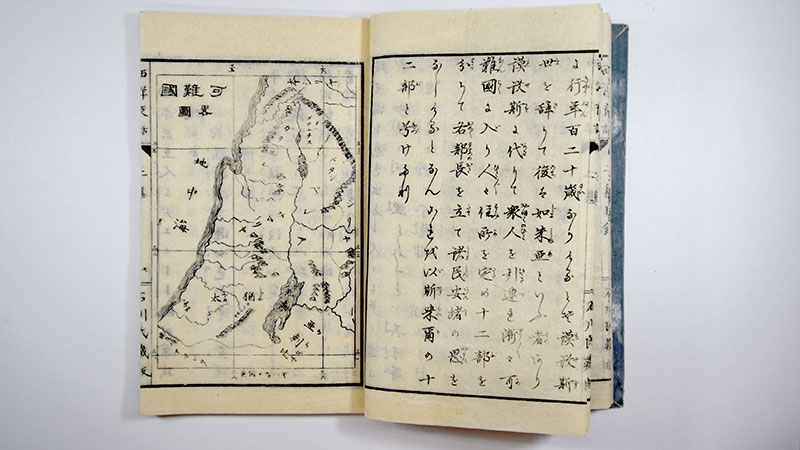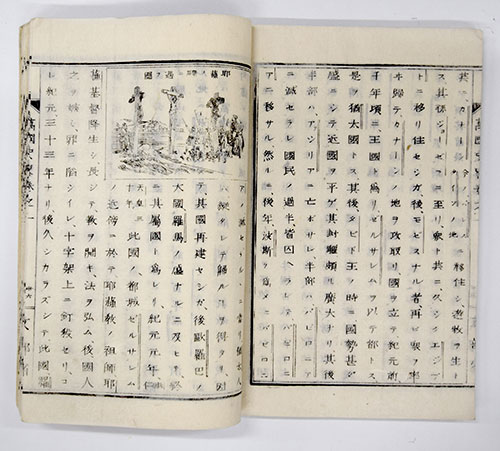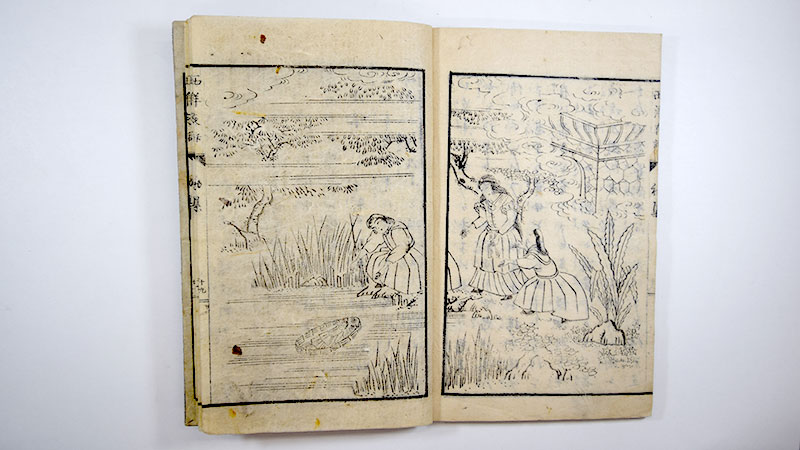During the embryonic period of Japanese modernization in the second half of the 19th century.
I have read William Carroll’s interview “The Rising Interest on Saint Thomas in China” (Humanitas Review 9) with great interest. He says, “Chinese scholars are interested in the ideas of Thomas Aquinas from an ethical rather than a metaphysical viewpoint”. As his interview suggests, it is intriguing to explore the way in which scholars and intellectuals in non-Christian cultures have received the works of Christian authors.
In this regard, I would like to discuss how Japanese intellectuals represented Christian subjects during the embryonic period of Japanese modernization in the second half of the nineteenth century. The propagation of Christianity was banned under the Tokugawa Shogunate (1603–1868) and when the Meiji government took over, in 1868, it retained the anti-Christian policy during its early administrative period but in 1873, it first permitted the dissemination of Christian beliefs. The freedom of religious faith of every individual was more clearly stipulated in the Meiji Constitution promulgated on February 11, 1889. Since then, Japanese elementary school students started to receive some knowledge of the Bible through school education. The Meiji government encouraged the Japanese to adopt Western ideas and technology to modernize Japan. Japanese scholars and intellectuals translated Western works into Japanese, although many of them were free or abridged translations or misrepresentations of original texts; these were not only scientific works but books on morality and history that included Christian subjects. The Ministry of Education recommended some of these works as elementary school textbooks. This piece considers the reason why Japanese authorities condoned the circulation of Western Books at schools including Christian subjects. It compares the descriptions of Jesus Christ in the original text of A Pictorial History of the World: Ancient and Modern, for the Use of Schools and Peter Parley’s Universal History, on the Basis of Geography by Samuel Griswold Goodrich (1793-1860) to two Japanese translations: Gosyū Kiji (Articles on five States) and Bankoku Shiryaku (World History).
Japanese Education in early Meiji period
The Meiji government adopted a centralized administrative system under the direct imperial rule of Emperor Meiji (1852–1912). It was composed of a small number of political leaders and bureaucrats, entrusted with powers by the Emperor. The leaders of the new government endeavored to adopt various Western systems, ideas, and technologies in order to modernize the nation. The enforcement of universal education was one of their remarkable achievements. The Code of Education and course of study for elementary school in 1872 required children from ages 6 to 13 to attend school, which was divided into low and high elementary levels of four years each. In the process of modernizing the educational system, the Meiji government engaged American educational specialists. One of them, David Murray (a professor at Rutgers College; 1830-1905) served as Superintendent of Educational Affairs in the Ministry of Education and Marion MaCarrell Scott (a teacher in California; 1843-1922) taught at normal school in Tokyo. They introduced Western pedagogies by bringing various American textbooks and teaching tools. Dairoku Kikuchi (1855-1917), the president of Tokyo Imperial University, related an anecdote about the invitation of an American teacher in the early Meiji Period in his lecture at the University of London in 1907, as follows:
“The Minister of Education at the time gave instructions to the American teacher that he was not to think of adapting his teaching to the Japanese, but was to teach just as he would at home. In consequence, the spelling books and wall diagrams were made after an American model, the only difference being the substitution of the Japanese alphabet for the American.” [1]
To establish universal education, the Ministry of Education recommended several works to serve as primary school textbooks in the course of study for elementary school. Yukichi Fukuzawa (1834-1901), one of Japanese ideological leaders and founder of Keio Gijyuku (predecessor of Keio University), wrote many of them, some of which were on the list of recommended texts:, Domo oshiegusa (A Junior Book of Morals), Gakumon no Susume (Encouragement of Learning), Seiyo Jijyo (Things Western), Kunmo Kyuri Zukai (Illustrated Books of the Physical World) and Sekai Kuni Zukushi (All the Countries of the World).
Fukuzawa, a rationalistic thinker, stated it in his autobiography, “I have never had any fear of gods and Buddha. Nor I have never faith in augury and magic, or in the fox and badger which, people say, have power to deceive men. I was a happy child, and my mind was never clouded by unreasonable fears” [2]. Such rationalism can also be seen in some of his student’s works that were also recommended as suitable textbooks for elementary school. Tenpen-Chii (A Convulsion of Nature) is a good example. The author, Tokujirō Obata (1842-1905), a student of Fukuzawa and third president of Keio Gijyuku, sought to interpret natural phenomena, such as thunder, earthquakes, comets, and rainbows, in a scientific manner. Before the Meiji period, most Japanese commoners regarded such happenings as directed by supernatural powers, in accordance with local traditions, usages, and superstitions. However, Obata argued for a modern understanding of natural events and in the preface he commented that people regarded earthquakes as caused by the wrath of the gods, when in fact they were scientific phenomena [3]. In this way, these authors tried to explain natural phenomena in a scientific manner.
In this ideological context, Fukuzawa was eager to receive works by American Christian authors to gain Western knowledge, and particularly interested in the works of Samuel Griswold Goodrich, the American author and publisher of books for children. Born into a family of a congregational minister, he founded a publishing house in Boston which published many books on history and natural history for children including Parley’s Common School History of the World, A Pictorial History of the World, Ancient and Modern, for the Use of Schools and Peter Parley’s Universal History on the Basis of Geography. These books on world history had a strong Christian perspective expressed in stories from the Old and New Testaments. When Fukuzawa traveled the United States in 1867, he purchased many copies of Goodrich’s works in Boston. He used Parley’s Common School History of the World, A Pictorial History of the World as a textbook at his private academy, Keiō Gijyuku [4].

Other than Fukuzawa, Guido Herman Fridolin Verbeck(1830-1898), a missionary of the Dutch Reformed Church and advisor for the Meiji government introduced Goodrich’s history books to Takatō Ōki (1832-1899) who was the Minister of Education in 1872 [5]. Thus, Goodrich’s works came to be known by intellectuals who translated them into Japanese, some of which were recommended as elementary school textbooks by Japanese authorities. The course of study for elementary school in 1872 recommended two translations of Goodrich’s titles as suitable textbooks for elementary school: Seiyō Yawa (Night Tales in the West) and Gosyū Kiji (Articles on Five States). The former was recommended as a textbook for Yomikata (reading) while the latter for learning history. Seiyō Yawa retells stories of the Old Testament with some illustrations such as the deluge, the Tower of Babel, Exodus, Entry into Canaan, the Reign of David, Wisdom of Solomon, Elijah and so on. However, this was not so with the New Testament, and the life of Jesus was not translated, despite Goodrich had focused on the Crucifixion and Resurrection of Jesus Christ as the focal point of the history of humanity. In this way, elementary school students could learn stories and moralities expressed in the Old Testament through these texts during the ban on Christian beliefs. Two Goodrich’s titles that were translated into Japanese touched on the story of Jesus Christ. One is Gosyū Kiji (Articles on Five States), translated by Shōmei Terauchi and published in 1872. Bankoku Shiryaku (World History) was published in 1874, one year after the lifting of anti-Christian edicts. This latter translation was published by the Ministry of Education.
The Description of Jesus Christ in Japanese Translations of Goodrich’s Works
Goodrich discussed Jesus Christ in two chapters, “The Hebrew Prophets” and “Crucifixion of the Savior.- Destruction of Jerusalem” in his two titles, Parley’s Common School History of the World, A Pictorial History of the World, Ancient and Modern, for the Use of Schools and Peter Parley’s Universal History on the Basis of Geography. He wrote in the chapter, “The Hebrew Prophets”, “Three wise men from the East beheld the star, and guided by it to a stable in the little village of Bethlehem. It was about five miles from Jerusalem. There, in a manger, lay the infant Jesus.” He continued in the following chapter “Crucifixion of the Savior. Destruction of Jerusalem” in the following passage:
“The greatest event, not only in the history of Jews, but in the history of the world, had now taken place. This was the coming of the Savior… The Jews rejected him. They had been looking for an earthly potentate; and when they beheld the meek and lowly Jesus, they despised and hated him. From the time that he proclaimed himself the Messiah, they sought to take his life. They brought him before the judgement-seat of Pontius Pilate, who was then the Roman governor of Judea. Pilate sentenced him to death, and the Savior of the world was crucified between two thieves. He however rose from the dead, after being buried three days, and ascended into heaven! [6]
How do Gosyū Kiji and Bankoku Shiryaku represent this passage? Here are the direct translation Japanese translations. Gosyū Kiji.
“Jesus Christ, the founder of Christianity, was born in this country after 2348 years from the deluge. Anno Domini calendar years starts from this event. A.D.1 applies to 30 years in the reign of Emperor Suinin and first year of Emperor Ping of Han Dynasty. The appearance of the star in the sky signed the birth of Jesus. Three wise men were guided by it to a stable five ri [7] from Jerusalem. They saw the infant Jesus, a descendant of the King David, in a manger. However, local peasants could not receive his teaching. He was arrested and taken to Pontius Pilate, who was then the Roman governor of Judea. Jesus was crucified to death by the sentence of Pilate. After being buried three days, his body disappeared abruptly. It is said that certainly he ascended into heaven" [8].
Terauchi described the Nativity and the Crucifixion, however, he deleted the original’s focal phrase on the Resurrection: “He however rose from the dead”. Terauchi rewrote it as, “After being buried three days, his body disappeared abruptly. It is said that certainly he ascended into heaven,” In this way, he diluted the expression of the Resurrection in the original text.
Another remarkable feature of this Japanese translation is that Terauchi dated the Nativity using three calendars (Calendar of Anno Domini, Japanese Imperial and Chinese Imperial eras), aiming to demythologize the Nativity. He was somewhat identifying Jesus Christ as a historical person who failed to propagate his religion on earth.
The same style is observed in the Bankoku Shiryaku (World History) translation where Jesus Christ is depicted as follows deleting completely the description of the Resurrection.
“Jesus Christ, the founder of Christianity, was born in the place near Jerusalem, in A.D.1 is equal to 30 years since the accession of Emperor Suinin. He was enlightened to start propagating his teaching. However his countrymen retained animosity against his work and plunged him to be charged. Consequently, he was crucified to death in A.D.33. This nation was to be ruined by the Roman Empire not long after his crucifixion”.

Both translations misrepresented Goodrich’s original intention. Their approaches to Jesus Christ was similar to that of historians who relied on scientific rationalism. Their positions were similar to Fukuzawa in early Meiji Japan who despised supernatural attributions. This might help to consider my question on the preface: why did Japanese authorities condone the circulations of Western books including Christian subjects.
Compared to Tokugawa Shogunate, the utilitarian and pragmatic stance of Japanese leaders in early Meiji Japan was somewhat tolerant of Christianity. This is a clear evidence of Japanese modernization for better for worse. However, that is not the end of the story. After lifting the ban on Christian belief in 1873, some Japanese young intellectuals were attracted and converted to Christianity.



